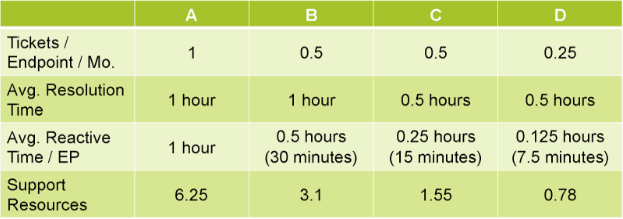The phone rings, and yet another client has a request or issue with their IT system. Are your employees spending all their time addressing calls like this?
The number of IT service tickets you manage each day, week and month is one of the biggest factors in your productivity level. In fact, most MSPs are crippled by this number.
But, not the top MSPs. They’re addressing less tickets per month, and their businesses are far more productive than the average MSP. So, what’s the secret?
Cutting the number of tickets you address per endpoint (any workstation or server where you have a remote management and monitoring agent installed) per month isn’t as difficult as you might think.
Why Do You Have So Many Tickets?
First, you must assess where all of them are coming from. Why are MSPs drowning under piles of IT service tickets?
Failing To Set Realistic Benchmarks
The first mistake most under-performing MSPs make is that they have no idea how many IT service tickets they should even have. This number varies greatly based on the size of your company, how many clients you’re working with and how many technical resources you have available.
As a benchmark, an average MSP with about 10 to 12 employees (7 to 9 of those employees having technical jobs) is able to support around 1,000 endpoints. For more comparisons, look to other companies like your own – that are similar in size – to determine the number of clients and endpoints you’re able to support.
Employing A Reactive Approach
If you’re always fighting to address the immediate problem in front of you, you’ll never be able to get a hold of the number of tickets coming in. Reactive IT service tickets are the most impactful reason why average MSPs aren’t top MSPs.
All user requests and monitoring alerts are considered reactive. Do most of the tickets your team addresses fall into that category?
Think of it this way: Anything that is scheduled – like a project, a vCIO or network administrator meeting or a centralized service delivery – is proactive. Anything that is unscheduled, like monitoring alerts, user requests and moves/adds/changes (MACs) is reactive. Having a more proactive grip on how your clients receive service leads to an upswing in productivity.
There are many ways to be more proactive in how you service your clients, including:
- Identifying where time is being wasted
- Aligning your client’s technology with your standards
- Hiring a network administrator, who ensures that your processes are applied properly to your clients’ solutions, monitors systems and upgrades networks before problems occur
- Streamlining your processes
- Anticipating and addressing issues before they arise by identifying areas of weakness in your clients’ networks and conducting upgrades to improve systems when necessary
The Solution To Your IT Service Ticket Dilemma
Assess the number of tickets you have coming in now versus the number you should have.
You need a way to compare your ticket levels to those of other MSPs. One way to do this is to evaluate the number of tickets per endpoint per month (T/EP/M) your team is addressing. This metric shows how many tickets your employees are facing in relation to the number of endpoints you support.
In the graph below, you’re able to see the impact of taking a more proactive approach. Companies A and B fall into the average MSP category, while the other two are top performers.

Set a goal of facing only 0.5 T/EP/M, and eventually achieving World Class status by generating as few as 0.25 T/EP/M. When you take a proactive approach to working with your clients, you’ll begin to see fewer tickets coming in, enabling you to achieve new levels of profitability.
Learn more about cutting IT service ticket numbers and taking a proactive approach to your IT services.


